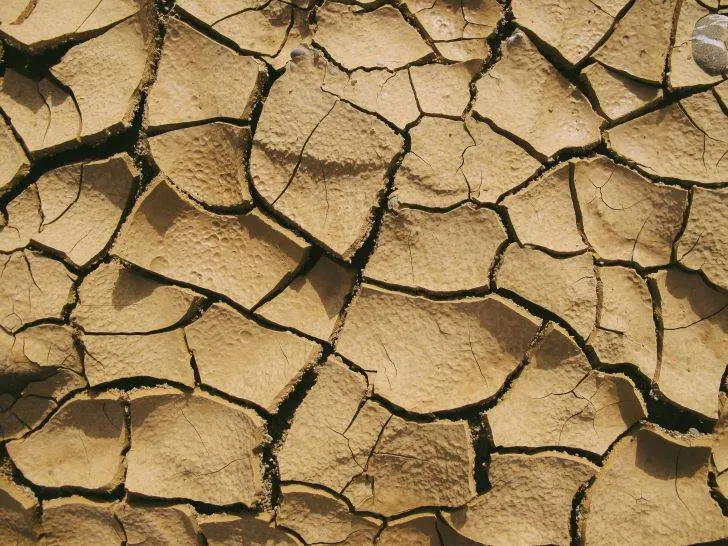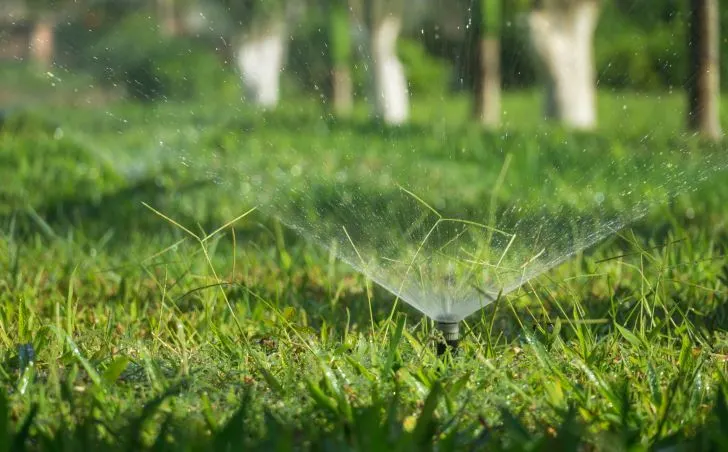Are you struggling with large cracks in your clay soil, hindering the growth of your plants and making your lawn look unsightly?
When this occurs, you may need to take some corrective actions to balance your soil’s composition. To maintain a healthy and good-looking lawn, it is necessary to prevent clay soil from cracking.
We have assembled all the necessary information regarding this topic.
In this article, we will look at why clay soil starts cracking, methods to fix it, and answers to some frequently asked questions.
As a result, you’ll be able to achieve a healthier and more vibrant lawn.
So, let’s get started and learn how to fix those annoying cracks in your clay soil.

What Causes Clay Soil to Crack?
Before moving toward the fixes, it is essential to learn the causes behind soil cracking. If you know what went wrong, you can fix the problem by making the right choices beforehand. Also, that will prevent it from happening again in time.
Clay soil behaves like a sponge, readily soaking up water and expanding in size. However, when it dries out, it shrinks down. The expansion, followed by shrinkage due to water loss, causes clay soil to crack.
Apart from that, there are other reasons that cause the clay soil to crack.
Let’s discuss all of these reasons in detail.
1. The Nature of Clay Soil
The characteristics of clay soil make it a unique and challenging soil type to work with.
With its small, flat particles, clay soil has a high binding capacity, but it can easily become unstable when it loses moisture, causing it to crack.
In contrast, sandy soil with larger pore spaces and faster drainage is less prone to cracking.
Improve Soil Structure
Although clay soil can be challenging to work with, using soil improvers can help improve its structure and make it more suitable for growing plants.
2. Soil Compaction
Soil compaction is a typical problem affecting all soil types, including clay soil.
It occurs when the soil particles are pressed together, reducing the pore spaces, and making it difficult for water to infiltrate and be absorbed. It can lead to water deficiency, making the soil more prone to cracking.
It also reduces the soil’s ability to support plant growth.
Compaction can be caused by heavy machinery, foot traffic, or even natural processes like raindrops hitting the soil surface.
Prevent Compaction
Prevent compaction by avoiding heavy machinery and limiting foot traffic on your clay soil, especially during wet conditions. Proper soil management techniques, like reduced tillage and soil aeration practices, help alleviate soil compaction and improve its health.
3. Loss of Moisture from the Soil
Clay soil’s unique property of having a high shrink-swell capacity makes it susceptible to cracking due to the changes in moisture content. As the soil loses moisture, the clay particles lose their ability to bind, thus resulting in large cracks.
It also happens during extended periods of low rainfall or drought.
Unfortunately, these cracks can create challenges for plants, making it difficult for roots to grow and access the moisture needed for growth. Moreover, soil cracks can increase its vulnerability to erosion, decreasing soil fertility.
Irrigate and Amend the Soil
To prevent the clay soil from cracking due to moisture loss, make sure to use a proper irrigation method, such as drip irrigation, to maintain moisture in the soil.
Moreover, you can improve the soil with amendments such as peat, compost, composted wood chips, hardwood bark, and perlite to increase its permeability.
4. Over-Irrigation
Over-irrigation is a common issue where excessive water is applied to the soil. This excess water makes the soil saturated, increasing pore water pressure.
That can be particularly problematic for clay soil, as it can become waterlogged and unstable, increasing the likelihood of soil cracking. Additionally, when soil is saturated, it reduces oxygen availability, further impeding plant growth.
The impacts of over-irrigation don’t stop there.
It can also lead to nutrient leaching and increased salinity in the soil, further exacerbating issues with plant growth and soil health.
Maintain a Watering Schedule
With time, you’ll get the hang of your lawn’s watering needs. Once you are there, make sure to maintain a proper watering schedule, and only water the soil when it is dry. If you are not able to do that yet, use a moisture meter to check if the soil needs water or not. That way, you’ll prevent overwatering it.
Also, if you’ve added moisture retaining soil improvers to your clay soil, it can lead to excessively wet soil conditions. That’s why soil amendments with higher water retention, such as vermiculite, aren’t good for clay soils.
5. Chemical Changes
Clay soil is subject to various chemical changes affecting its health and quality. These changes can be caused by several factors, including imbalanced nutrients, soil salinity, and pH levels.
For example:
Highly acidic clay soil can weaken the bonds between clay particles and lead to soil cracking. High soil salinity can also destabilize soil particles, increasing the likelihood of cracking.
Test the Soil
You’ll need to test your soil to see if the cracking is due to a chemical change. Start by determining the pH level of your soil to understand the extent of acidity.
After that you can apply certain materials to change the pH of your clay soil.
Methods to Fix Large Cracks in Clay Soil
I hope you understand the causes of large cracks in your clay soil.
Fortunately, several methods are available to fix these cracks.
1. Topdressing
Topdressing is a soil improvement technique that involves adding a layer of soil or organic matter to the surface of a garden bed. This method effectively improves soil structure and prevents large cracks in clay soil.
Topdressing is important because it is a process that can take several applications to get significant long-term results.
Now let me tell you some common materials used for top dressing.
Materials Used for Topdressing
There are several materials that can be used for topdressing, including:
- Organic materials such as compost, leaf mold, or well-rotted manure. These materials can help to improve soil structure and fertility over time.
- Peat moss is another organic material that can improve soil structure and water-holding capacity.
- Grass clippings are a good nitrogen source and can be used as a top dressing to provide nutrients to the soil. However, they should be used sparingly and only when dry to avoid clumping and smothering the lawn.
- Leaves can also be used as topdressing, but they should be shredded first to prevent matting and to allow for air and water penetration. Leaves are a useful source of organic matter and can help improve soil structure.
That said, let’s move toward our next method.
2. Proper Irrigation
In clay soil, proper irrigation is important to maintain soil moisture and prevent large cracks from forming. Proper irrigation can also help to distribute nutrients throughout the soil in a consistent manner.
Various irrigation systems are available to ensure proper watering, each with advantages and disadvantages:
- Sprinkler systems, for example, are a common choice for large-scale irrigation because they can cover a large area quickly and efficiently.
- Drip irrigation systems, on the other hand, are more precise and use less water, making them ideal for areas with water restrictions.
Remember! Over-irrigation can lead to waterlogged soil and root rot, while under-irrigation can cause plants to wilt and die.

3. Soil Aeration
Aeration is the process of creating small holes or channels to allow air, water, and nutrients to penetrate deeper into the soil.
In clay soil, aeration is important to improve drainage and prevent waterlogging.
There are three main types of soil aeration.
Core Aeration
Core aeration, mechanical aeration, or soil cultivation involves using a machine with hollow tines to remove small plugs or cores of soil from the ground.
The process creates holes in the soil, allowing air and water to penetrate more easily. The removed cores break down over time and help improve soil structure.
Core aeration is commonly used on lawns, athletic fields, and agricultural fields.
Spike Aeration
Spike aeration involves using a machine with solid tines to poke holes in the soil without removing cores.
While this method can provide some aeration benefits, it can also create compaction around the holes, making it less effective than core aeration.
Liquid Aeration
Liquid aeration involves applying a liquid solution to the soil that contains soil-loosening agents, such as humic acid.
The solution works by breaking up compacted soil and improving soil structure.
This method is typically less effective than mechanical aeration but can be a good option for smaller areas. However, there has been no scientific evidence that this method works to improve soil compaction.
It can be used in conjunction with mechanical aeration for added benefits.
4. Soil Replacement
This method is useful when the cracking is too severe and other methods, such as irrigation or mulching, are ineffective.
The soil replacement method involves removing and replacing the damaged soil with new soil.
- The first step is to remove the damaged soil by excavating it to a certain depth. The depth will depend on the severity of the cracking and the desired soil quality of the new soil.
- Once the damaged soil is removed, the new soil is brought in and placed in the excavated area. The new soil should have a similar texture and composition to the existing soil in the area to ensure compatibility.
Soil replacement can effectively repair large cracks in clay soil but can also be costly and time-consuming. It is important to properly prepare the area and select the appropriate new soil to ensure the best results.
Answer to Some FAQs
Now, let’s answer some frequently asked questions about this topic.
Can I Use Sand to Fill Cracks in Clay Soil?
Using sand to fill cracks in clay soil is not recommended as it can make the situation worse.
Sand particles filled in the cracks create a more compacted soil layer that may lead to more cracking and poor soil structure. Instead, use soil amendments, proper irrigation, and mulching to prevent cracking.
For example, look how this man uses compost to fill up the cracks in heavy clay soil:
How Often Should I Water Clay Soil to Prevent Cracking?
The watering frequency to prevent clay soil from cracking depends on numerous factors, such as climate, soil type, and plant type.
However, as a rule of thumb, it is recommended to water clay soil deeply and typically about 1–2 inches per week.
How Long Does It Take to Fix Large Cracks in Clay Soil?
The time it takes to fix large cracks in clay soil depends on the severity of the problem and the methods used to fix it. It may take several weeks or months to see significant improvements in the soil structure and a reduction in cracking.
That’s all!
Let’s head toward the conclusion.
Conclusion!
I hope that now it is clear to you what you need to do to fix your clay soil.
There are several methods to do so, but before choosing the right method to fix your soil, it is crucial to find the cause.
If other methods are not fixing large cracks in your clay soil, it is better to go for the soil replacement method. Though it is a time-consuming and costly technique, there is a surety of effective results.
I hope you find this post beneficial.
If you have any queries regarding this topic, please feel free to mention them in the comment section below.
Regards,
Moiz Atiq.
